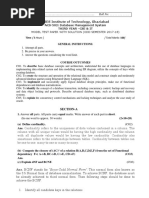Assignment - 1
Uploaded by
hanishtadi7777Assignment - 1
Uploaded by
hanishtadi7777Assignment-1
1. Define insertion anomalies, deletion anomalies, and update anomalies. Provide an example for each
anomaly, demonstrating how poorly designed schemas can lead to data redundancy and inconsistency.
2. Given the following set of attributes and FDs, determine the minimal cover of the functional
dependencies and explain the reasoning behind each step. R(A, B, C, D, E)
FDs: A → B, BC → D, D → E, A → C
3. (a) Explain the concept of closure of a set of functional dependencies. How is it used in database
design?
(b) Given the following relation and FDs, compute the closure of the set of attributes {A, B}.R(A, B, C, D)
FDs: A → C, B → D, AB → C
4. Given the following relation, normalize it step-by-step from 1NF to BCNF and explain each step:
R(StudentID, CourseID, Instructor, Grade, Department)
FDs: StudentID, CourseID → Grade, Instructor → Department
5. Consider the following relation:R(A, B, C, D)
Multi-valued dependencies: A →→ B, A →→ C
Normalize the relation to 4NF and explain the process.
6. Given a relation R(A, B, C, D) with the FDs:A → B, C → D
Decompose the relation into smaller relations. Check if the decomposition is lossless and whether it
preserves dependencies.
7. Consider the following relation R(A, B, C) and the set of FDs: A → B, B → C
Is the functional dependency A → C implied by the given set of FDs? Justify your answer using closure or
Armstrong’s Axioms.
8. Given a relation R(A, B, C, D, E) and the FDs:A → B, C → D, B → E
Perform a BCNF decomposition and check if the resulting decomposition is dependency-preserving.
9. Discuss a situation where denormalization might be beneficial despite the anomalies that arise from
it. Provide examples from a practical application such as a data warehouse or OLAP system.
10. Given the relation R(A, B, C, D, E) and the FDs:A → B, C → D, D → E
Demonstrate how this schema could suffer from update anomalies if it is not normalized. Perform
normalization to resolve the anomalies and explain the process.
You might also like
- Hourglass Workout Program by Luisagiuliet 276% (21)Hourglass Workout Program by Luisagiuliet 251 pages
- The Hold Me Tight Workbook - Dr. Sue Johnson100% (16)The Hold Me Tight Workbook - Dr. Sue Johnson187 pages
- Read People Like A Book by Patrick King-Edited62% (66)Read People Like A Book by Patrick King-Edited12 pages
- Livingood, Blake - Livingood Daily Your 21-Day Guide To Experience Real Health77% (13)Livingood, Blake - Livingood Daily Your 21-Day Guide To Experience Real Health260 pages
- COSMIC CONSCIOUSNESS OF HUMANITY - PROBLEMS OF NEW COSMOGONY (V.P.Kaznacheev,. Л. V. Trofimov.)94% (212)COSMIC CONSCIOUSNESS OF HUMANITY - PROBLEMS OF NEW COSMOGONY (V.P.Kaznacheev,. Л. V. Trofimov.)212 pages
- Donald Trump & Jeffrey Epstein Rape Lawsuit and Affidavits83% (1016)Donald Trump & Jeffrey Epstein Rape Lawsuit and Affidavits13 pages
- The 36 Questions That Lead To Love - The New York Times94% (34)The 36 Questions That Lead To Love - The New York Times3 pages
- The 36 Questions That Lead To Love - The New York Times95% (21)The 36 Questions That Lead To Love - The New York Times3 pages
- Jeffrey Epstein39s Little Black Book Unredacted PDF75% (12)Jeffrey Epstein39s Little Black Book Unredacted PDF95 pages
- The 4 Hour Workweek, Expanded and Updated by Timothy Ferriss - Excerpt23% (954)The 4 Hour Workweek, Expanded and Updated by Timothy Ferriss - Excerpt38 pages
- Advanced C++ Interview Questions You'll Most Likely Be AskedFrom EverandAdvanced C++ Interview Questions You'll Most Likely Be AskedNo ratings yet
- ACFrOgCK8d qx6yIxOeRqfBi5-IzmTuxFV3MadZ0abymeKDqroisQWmlZDwwQPkY8jB8YEEJpIT0L95cAmqXTJdTB2JK2RoQLSSJjr2ZbwFBGlFW6kWhidXcYBqRPKJtDcnlRTNyRzqkt9J3t2nnNo ratings yetACFrOgCK8d qx6yIxOeRqfBi5-IzmTuxFV3MadZ0abymeKDqroisQWmlZDwwQPkY8jB8YEEJpIT0L95cAmqXTJdTB2JK2RoQLSSJjr2ZbwFBGlFW6kWhidXcYBqRPKJtDcnlRTNyRzqkt9J3t2nn3 pages
- CSCI235 Autumn2014 Assignments Assignment 2No ratings yetCSCI235 Autumn2014 Assignments Assignment 24 pages
- IT 220 Unit 4 Relational-Database-DesignNo ratings yetIT 220 Unit 4 Relational-Database-Design56 pages
- Decomposition: by Yuhung Chen CS157A Section 2 October 27 2005No ratings yetDecomposition: by Yuhung Chen CS157A Section 2 October 27 200523 pages
- Birla Institute of Technology & Science, Pilani II SEMESTER 2017-2018 BITS F212 - Database SystemsNo ratings yetBirla Institute of Technology & Science, Pilani II SEMESTER 2017-2018 BITS F212 - Database Systems1 page
- What Is Database?: DBMS Overview, RDBMS V/s DBMS, File System & DBMSNo ratings yetWhat Is Database?: DBMS Overview, RDBMS V/s DBMS, File System & DBMS13 pages
- Assignment 1 This Assignment Should Be Done in Groups and Submitted On Google Class by 26 June 2020No ratings yetAssignment 1 This Assignment Should Be Done in Groups and Submitted On Google Class by 26 June 20202 pages
- CU-2020_B.Sc._(Honours)_Computer_Science_Semester-V_Paper-CC-11_QPNo ratings yetCU-2020_B.Sc._(Honours)_Computer_Science_Semester-V_Paper-CC-11_QP2 pages
- Relational Database Design: Practice Exercises0% (1)Relational Database Design: Practice Exercises6 pages
- E D1071 Pages: 4: Limit Answers To The Required Points. Answer All Questions, Each Carries 3 MarksNo ratings yetE D1071 Pages: 4: Limit Answers To The Required Points. Answer All Questions, Each Carries 3 Marks4 pages
- Birla Institute of Technology & Science, Pilani II SEMESTER 2017-2018 CS F212 - Database SystemsNo ratings yetBirla Institute of Technology & Science, Pilani II SEMESTER 2017-2018 CS F212 - Database Systems2 pages

























































































